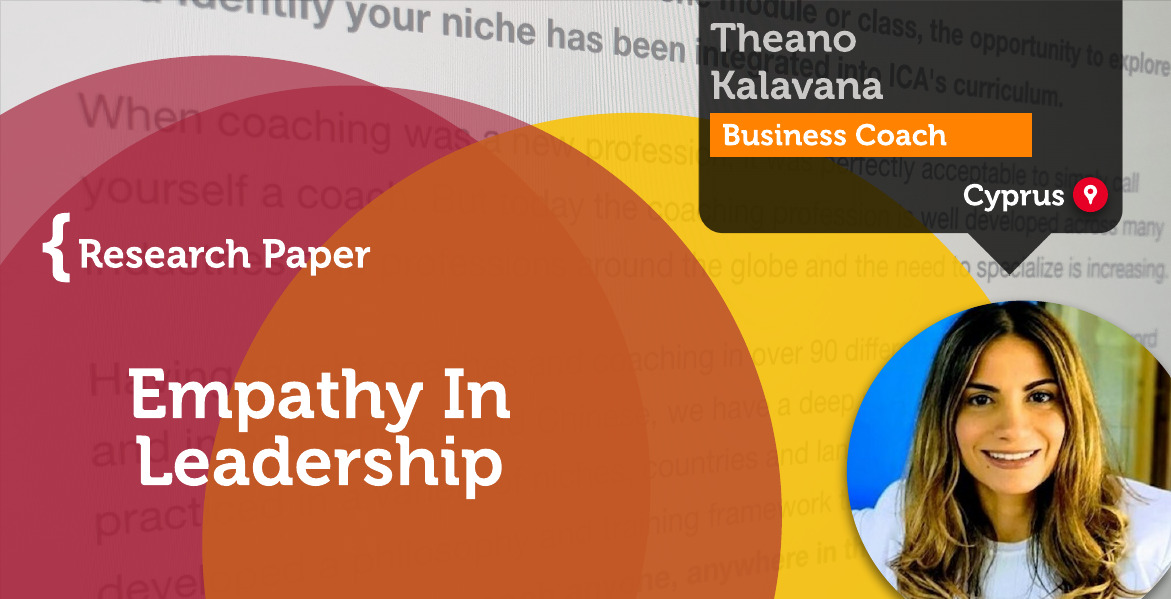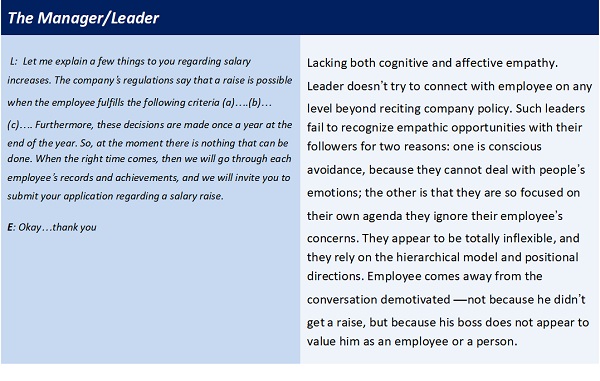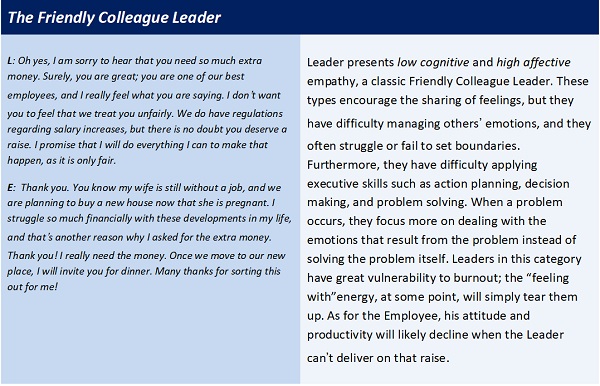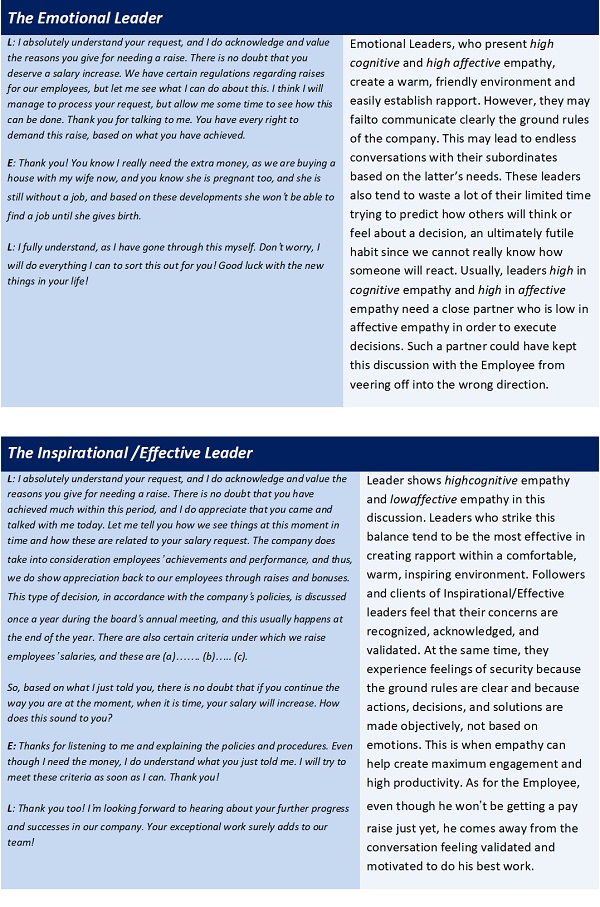Research Paper By Theano Kalavana, Business Coach, CYPRUS

Balancing Empathy in Leaders
I was always looking outside myself for strength and confidence but it comes from within. It is there all the time. Anne Freud
A brief story as to how my interest in empathy in leadership started:
A few years ago an international company asked me to collaborate with them to build simulation training on soft skills for leaders such as empathy, negotiation skills, and communication skills. Since then, I have been involved in many processes for the development of authentic leaders. Two years ago the CEO of the same international consultant’s company proposed to me to write together an article on empathy, after reading a chapter of mine on why doctors fail to respond to patients’ emotions. Since then, my focus shifted from doctors to leaders and how soft skills such as empathy and awareness can transform leaders into authentic leaders. The present article is my second attempt to marry coaching with balancing empathy in leaders (the first was with the development of my power tool Cognitive Empathy vs. Affective Empathy).
Below is the information of the article and the chapter. Some parts of the article titled “Finding the Right Level of Empathy” will be used in the present article:
Kalavana T.V. & Andreou P. (March 2018) Finding the Right Level of Empathy. Chief Learning Officer Magazine.
Brown et al. (2015). Clinical Communication in Medicine. Kalavana, T.V Responding to patient’s emotions. United Kingdom: John Wiley & Sons, Ltd.
Empathy In Leadership
The literature supports that empathy is strongly linked to leadership success (Cooper & Sawaf, 1997) and it also correlated with a positive impression about the leaders (Kellett et al.2002). In doctor-patient relationships, for example, empathy has been shown to help in three ways: it encourages patients to share more information with their physician, it empowers patients to take a more active role in their treatment, and it establishes a therapeutic interaction that helps in the patients’ recovery process (Di Blasi et al., 2001). The same benefits translate to the business world by showing an awareness of, and concern for, the needs of others, managers strengthen their standing as leaders, enhance their credibility, and improve their team’s attitudes and emotions. Even though evidence supports the importance of empathy in leadership, there is danger in being empathic in such a way as to lose or diminish executive leadership skills such as planning, organizing, problem-solving, and decision making. The present article will try to discuss how coaching and mindfulness can be helpful when leaders pick up empathetic opportunities and respond. Goleman et al (2002) argued that successful leaders are those who can leverage emotional and social competencies.
Definition of Empathy and Types
Empathy is defined as “the ability to comprehend another’s feelings and to re-experience them oneself”. Empathy represents one of the most important aspects of emotionally intelligent behavior (Salovey & Mayer, 1990, pp.194-195) and involves both a cognitive (understanding another state) and an affective (sharing another’s state) component (Eisenberg, 2000). Great leadership hinges on understanding the difference and how to harness the unique power of each.
Cognitive Empathy
Cognitive empathy is what allows leaders to balance their relationships by creating a comforting, friendly atmosphere with their employees, while also encouraging the latter’s self-efficacy. This level of clarity benefits everyone involved in the interaction. At the same time, the leader can perform well on executive skills. Using cognitive empathy requires leaders to think about feelings rather than to feel them directly. Cognitive empathy is an outgrowth of self-awareness.
Affective Empathy
Affective empathy can likewise help leaders build trust, rapport, and cooperation. This is important for ensuring employee engagement, but it may work against an objective decision-making process. In heavy doses, affective empathy can also have other side effects. Studies have shown that physicians who strongly identify with their patients’ emotions suffer personal distress and a decline in professional performance (Lamothe et al, 2014), and are prone to emotional exhaustion (Girgis, Hansen & Goldstein, 2009). While most executives aren’t dealing with life or death issues, the stakes often feel just as high. Business leaders who can’t keep some emotional balance from the problems of the people they see at work every day may be as susceptible as doctors to burnout.
Different Styles of Empathy
The following matrix combines cognitive and affective empathy and forms Four Types of Leaders According to Their Empathy Styles (Kalavana & Andreou, 2018).
See Appendix for detailed examples for each style

Coaching to B.A.L.A.N.C.E. Empathy – Mindfulness
Goleman (2011) underlined that the antidote for affective empathy that can lead to emotional exhaustion is “emotional self-management skills”.
Empathy styles have serious implications for everyday interactions that ultimately lead to the success or failure of a business. A leader who maintains a balance between cognitive and affective empathy can nurture for their people a feeling of “closeness” and of being understood and appreciated, while also helping to create a high-performing organization that achieves its targets for growth and profitability. Fortunately, empathy isn’t an inherent trait, but a muscle that leaders can develop through coaching.
Therefore, shifting from the heart-to-heart empathy and balance emotions to a more head-to-heart empathy is possible through the mindfulness model that I called B.A.L.A.N.C.E.
Mindfulness is also acknowledged by NICE (National Institute for Health and Care Excellence) as an effective kind of therapy with physical and psychological stress (Sweet, 2014). Mindfulness is about changing the relationship between our thoughts and feelings and thus creates the space between thoughts, emotions, and actions which are important for leaders when they need to respond empathetically.
B.A.L.A.N.C.E. as one of the Mindfulness Coaching Models
B – Breath
In Mindfulness, breathing is one of the most important techniques to calm the mind and to strengthen concentration. There are so many techniques to breathe both in mindfulness and meditation. The importance during breathing technique is to allow six to seven seconds when you breathe in and another six to seven seconds when you breathe out. It is important to focus and pay attention to every single breath as it is the only one you have and you have to catch it as much as you can.
A – Attention
Jon Kabat-Zinn (2012) said: “Mindfulness means paying attention in a particular way: on purpose, in the present moment and non-judgementally”. Breaths are always with us, it is essential when we need to be mindful to pay attention first to our breaths, then to pay attention to what is happening at that moment. It is important to pay attention to the moment, to the present. It doesn’t matter how good a leader is someone or how good skills he/she has if he/she doesn’t pay attention then he/she cannot be in the moment and become fully aware. These are some of the questions that can facilitate attention:
- What do I see?
- What do I hear?
- What is my body posture at the moment?
- What are my facial expressions at the moment?
L – Listen
Listening to what is happening at the moment is really important. Be an active listener means that you need to block your own thoughts, feelings, ideas, biases, prejudices, and assumptions. Be in the moment, listen not only to what it is said but also to the body language of the person talking to you. Listen to the tone of the voice, their breaths, their paste, their facial expressions, and their movements. Listen to understand not to fix or to respond. These are some questions that can facilitate listening:
- What do you hear?
- What do you notice about the tone of the voice and paste?
- What emotions are accompanying the message that you hear?
- Can you paraphrase with your own words what was mentioned and how?
A – Awareness
Awareness is the task of identifying the differences between facts, interpretations, and disparities between thoughts, feelings, and actions. Goleman (2011) presented three emotional competencies under the category of self-awareness, these are: (a) Emotional awareness: recognizing your own emotions and their effects (b) Accurate self-assessment: knowing your own strengths and limitations (c) Self-confidence: a strong sense of self-worth and capabilities. Two important techniques to develop your self-awareness are (a) body scan, moving your attention from head (1 min), to face(1 min), to neck and shoulders (1 min), to back (1 min), to front(1 min) and the entire body at once (1 min) and (b) emotional scan (moving your attention to the feelings and thoughts (Chate-Meng, 2012). These are some questions that can facilitate awareness:
- What thoughts are going through the mind?
- What feelings are here now?
- What body sensations are here right now?
- What do you sense is happening at the moment?
N – Notice
Based on the previous steps, notice yourself, the other person, and the situation. What is the experience you get in the moment? Is it a feeling, a thought, or an urge to react? Notice what it is and give it a name. Giving names to our thoughts, emotions or actions help us to manage them better because we gain clarity of what is it that we really experience(Chate-Meng, 2012). In this step you just notice and name it, don’t judge yourself for feeling or thinking this way, and don’t react in any way based on what you notice. Just “BE”. Let yourself be, let go completely and drop everything about it.
These are some questions that can facilitate this step:
- Can you give a name to this thought?
- Can you give a name to this feeling?
- If it was a picture what it will be?
- If it was a movie what will be the reactions of the main character?
C – Connect
Being mindful and becoming self-aware helps you to connect to what is happening outside of you with what is happening inside of you. Being able to identify and connect with yourself, the other, and the situation at the moment. Connecting to where emotions are coming from, where thoughts are coming from, what you bring in this moment, how your past is interfering with the present, any triggers that urge you to react in a certain way. Connect without using judgment. Connect with the other person and try to put yourself in their position and see how this person is looking at you, what connection is there? Connect with the situation without acting out, just understand, accept and connect. These are some questions that can facilitate the step to connect:
- Where the thoughts are coming from?
- Where the emotions are coming from?
- Is it the person?
- Is it the situation?
- What triggers are there for me at this moment?
- What do I bring in the moment?
E – Expand
Expanding your awareness through mindfulness helps you to manage your emotions and control your actions. It is admitted that emotional state can rapidly shift into fear or anxiety, this reactivity takes place in the limbic system (emotional brain) which then gives signals to other parts of the brain to regulate emotions that’s why people experience changes in the way of thinking (not thinking clearly), their attention and behavior. This is what happens when we are “hijacked” by our emotions (Goldin, 2008). Expanding awareness is basically a way of expanding your responses based on this new awareness. It is mainly managing to break the vicious cycle of thoughts and feelings by unlocking underlying beliefs and manage emotions by responding in a totally new way. These are some questions that can facilitate the step of expanding awareness and thus create new responses:
- What could you do differently based on this awareness?
- What might be an alternate response this time?
- What is true about that thought or feeling?
- What can be a response to this moment that will make you happy?
- What can be a response to this moment that would have a positive outcome?
- What would that outcome look like?
Mindfulness is one of the frameworks and B.A.L.A.N.C.E. is one of the models that can be used in coaching to help leaders managing their emotional skills. Of course in the present era in which coaches need to manage through VUCA (volatility, uncertainty, complexity, and ambiguity) in business, it is a necessity for the coach to develop further frameworks, models, and skills when working within virtual communication with leaders to help them to strengthen their emotional management skills.
Finally, no matter what the concept or the mean of coaching will be (virtual or face to face) coaching process and relationship will always be a safe space that allows the leader to develop awareness and make a shift in skills, behaviors, and actions. Additionally, coach–leader relation will always act as a role model for the relation leader is creating with his/her people.
References
Chate-Meng, T. (2012). Search inside yourself: Increase productivity, creativity, and happiness. UK: Collins.
Cooper, R. K., & Sawaf, A. (1997). Executive EQ: Emotional Intelligence in leadership and organizations.New York: Grosset/Putman.
DiBlasi, Z.D., Harkness, E., Ernst. E., Georgiou. A Kleijnen, J. (2001). Influence of context effects on health outcomes: a systematic review. Lancet, 357, 757-762.
Eisenberg, N. (2000). Empathy and sympathy. In M. Lewis & J.M.Haviland-Jones (Eds.), Handbook of emotions (pp.677-691). New York: Guilford Press.
Girgis, A., Hansen, V., Goldstein, D. (2009). Are Australian oncology health professionals burning out? A view from the trenches. European Journal of Cancer, 45, 393-399.
Goldin, P. (2008). The neuroscience of Emotions.
Goleman, D. (2002). Primal Leadership: Realizing the Power of Emotional Intelligence. Business School Press: Boston, Mass
Goleman, D. (2011). The brain and emotional intelligence: new insights. More than Sound, Northampton, M.A.
Kabat- Zinn, J. (2012).Mindfulness for Beginners: reclaiming the present moment – and your life. Sounds True, Inc.
Kalavana T.V.&Andreou P. (2018). Finding the Right Level of Empathy. Chief Learning Officer Magazine.
Kellett, J.B., Humphrey, R.H., & Sleeth, R.G. (2002). Empathy and complex task performance: Two routes to leadership. Leadership Quarterly, 13(5), 523-544.
Lamothe, M., Boujut, E., Zenasni, F., Sultan, S. (2014). To be or not be empathic: the combined role of empathic concern and perspective-taking in understanding burnout in general practice. BMC Family Practice, 15(15), 1-7.
Salovey, P.&Mayer, J.D. (1990). Emotional intelligence.Imagination, Cognition and Personality, 9(3), 185-211.
Sweet, C. (2014). The Mindfulness Journal. London: Boxtree.
Appendix
*L=Leader and E= Employee


